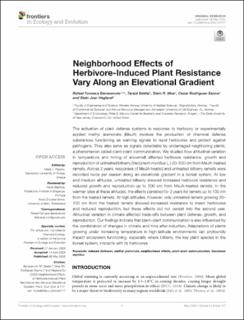| dc.contributor.author | Fonseca Benevenuto, Rafael | |
| dc.contributor.author | Seldal, Tarald | |
| dc.contributor.author | Moe, Stein Ragnar | |
| dc.contributor.author | Rodriguez-Saona, Cesar | |
| dc.contributor.author | Hegland, Stein Joar | |
| dc.date.accessioned | 2020-12-04T13:44:40Z | |
| dc.date.available | 2020-12-04T13:44:40Z | |
| dc.date.created | 2020-11-03T15:46:38Z | |
| dc.date.issued | 2020 | |
| dc.identifier.citation | Frontiers in Ecology and Evolution. 2020, 8, 117 | en_US |
| dc.identifier.issn | 2296-701X | |
| dc.identifier.uri | https://hdl.handle.net/11250/2711993 | |
| dc.description.abstract | The activation of plant defense systems in response to herbivory or experimentally applied methyl jasmonate (MeJA) involves the production of chemical defense substances functioning as warning signals to repel herbivores and protect against pathogens. They also serve as signals detectable by undamaged neighboring plants, a phenomenon called plant–plant communication. We studied how altitudinal variation in temperature and timing of snowmelt affected herbivore resistance, growth and reproduction of untreated bilberry (Vaccinium myrtillus L.) 20–500 cm from MeJA-treated ramets. Across 2 years, responses of MeJA-treated and untreated bilberry ramets were recorded twice per season along an elevational gradient in a boreal system. At low and medium altitudes, untreated bilberry showed increased herbivore resistance and reduced growth and reproduction up to 500 cm from MeJA-treated ramets. In the warmer sites at these altitudes, the effects persisted for 2 years for ramets up to 100 cm from the treated ramets. At high altitudes, however, only untreated ramets growing 20–100 cm from the treated ramets showed increased resistance to insect herbivores and reduced reproduction, but these effects did not persist into the second year. Altitudinal variation in climate affected trade-offs between plant defense, growth, and reproduction. Our findings indicate that plant–plant communication is also influenced by the combination of changes in climate and time after induction. Adaptations of plants growing under increasing temperature in high-latitude environments can profoundly impact ecosystem functioning, especially where bilberry, the key plant species in the boreal system, interacts with its herbivores. | en_US |
| dc.language.iso | eng | en_US |
| dc.rights | Attribution-NonCommercial-NoDerivatives 4.0 Internasjonal | * |
| dc.rights.uri | http://creativecommons.org/licenses/by-nc-nd/4.0/deed.no | * |
| dc.title | Neighborhood effects of herbivore-induced plant resistance vary along an elevational gradient | en_US |
| dc.type | Peer reviewed | en_US |
| dc.type | Journal article | en_US |
| dc.description.version | publishedVersion | en_US |
| dc.source.pagenumber | 12 | en_US |
| dc.source.volume | 8 | en_US |
| dc.source.journal | Frontiers in Ecology and Evolution | en_US |
| dc.identifier.doi | 10.3389/fevo.2020.00117 | |
| dc.identifier.cristin | 1844610 | |
| dc.source.articlenumber | 117 | en_US |
| cristin.ispublished | true | |
| cristin.fulltext | original | |
| cristin.qualitycode | 1 | |

